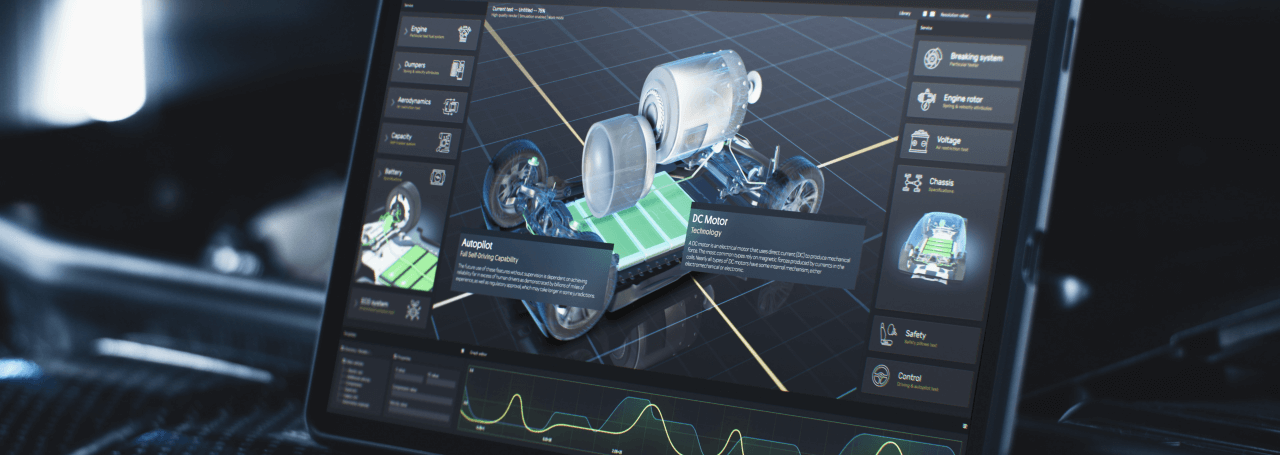- Analyzing industry and outdoor-specific requirements
- The application overview—from terminology to functionality
- Brightness requirements for indoor and outdoor use
- Importance of wide viewing angles in public-facing applications
- 24/7 operation and LED backlight lifetime
- Extreme temperature handling with high-TNI liquid crystals
- Vandal resistance and touch interaction through thick protective glass
- Riverdi’s approach to testing and qualifying displays for public space applications
PART 1.
Analyzing industry and outdoor-specific requirements
Displays used in public space devices—ranging from digital signage to interactive EV chargers and parcel terminals—must meet significantly higher performance and durability standards than typical consumer screens. In this first part of our series, we take a closer look at the specific requirements that define these demanding environments. From brightness and viewing angles to temperature ranges and vandal resistance, we explore what it takes for a display to perform reliably in high-traffic, high-exposure scenarios—and how Riverdi designs its products to meet those challenges.
Topics covered:
- The application overview—from terminology to functionality
- Brightness requirements for indoor and outdoor use
- Importance of wide viewing angles in public-facing applications
- 24/7 operation and LED backlight lifetime
- Extreme outdoor temperature handling with high-TNI liquid crystals
- Vandal resistance and touch interaction through thick protective glass
- Riverdi’s approach to testing and qualifying displays for public space deployment
The application overview—from terminology to functionality
When integrating displays into public environments, it’s important to distinguish between two key application types: digital signage and public space devices. Although they often share similar technologies, their roles and usage contexts differ significantly.
Digital signage refers to display solutions designed primarily to present information to the public. These include real-time weather updates, transport schedules at bus stops, advertisements, or announcements in galleries and public halls. Such screens are usually large and intended to be visible from a distance, delivering content to a broad audience without direct user interaction.
Public space devices, by contrast, form a broader category that also includes interactive systems. These are devices like EV chargers or parcel terminals, where the display acts as a user interface. In this case, the screen is typically smaller and serves a practical, functional purpose—guiding the user through tasks such as retrieving a package or operating a self-service station. While these displays can show promotional content, their core purpose is to enable interaction rather than just convey information.
Both types of displays enhance everyday experiences in public areas by improving communication, navigation, and accessibility. From airports to shopping centers, clearly visible and well-placed screens help users find information quickly and navigate complex environments more efficiently—ultimately making public spaces easier and safer to use and to live in.
Brightness requirements for indoor and outdoor use
Displays located in public spaces—whether indoors or outdoors—must be readable in challenging lighting conditions. This makes brightness one of the essential parameters in their design. Unlike home or office displays, which typically operate in controlled lighting environments, public space displays often face strong ambient light or even direct sunlight.
In indoor public settings such as shopping malls, train stations, or airports, lighting levels are generally much higher than in typical living rooms or workplaces. Standard consumer monitors and televisions usually offer brightness levels in the range of 250 to 300 candela/m². In contrast, displays intended for public spaces require significantly higher luminance to ensure content remains readable at all times. A minimum of 700 cd/m² is commonly required for such environments—more than double that of a typical desktop monitor.
Mobile devices offer a helpful comparison: because smartphones are often used outdoors, many include special high-brightness modes that can boost screen luminosity to 1,500–2,000 cd/m² to maintain visibility in direct sunlight. However, this comes at the cost of rapid battery drain and temperature increase, limiting such performance to a few minutes.
For public space applications, where devices are often installed permanently and operate continuously, high brightness must be both sustainable and efficient. This demands careful temperature management and durable LED backlight designs.
| Application | Environment | Recommended brightness |
| Consumer TV / Monitor | Indoor (home) | 250–300 cd/m² |
| Indoor public signage (mall, airport) | Bright indoor space | ≥700 cd/m² |
| Smartphones (outdoor mode) | Direct sunlight | 1500–2000 cd/m² |
| Outdoor public space | Direct sunlight | up to 1000 cd/m² Riverdi’s standard IPS displays for public space |
Importance of wide viewing angles in public-facing applications
Unlike personal devices, typically viewed straight on, public-facing displays must remain readable from multiple directions—whether viewed from above, below, or from the sides. This is especially important in high-traffic environments where people approach screens from various angles and distances.
To meet these demands, Riverdi uses IPS technology with IBS or MVA. IPS panels offer consistent image quality and accurate color reproduction across a full viewing angle, making them ideal for digital signage and interactive kiosks. This way the end-user experience is based upon clear, distortion-free visuals from all sides.
In contrast, lower-cost TN (Twisted Nematic) panels—commonly found in basic home desktop monitors—have limited viewing angles. One significant drawback of TN technology is the occurrence of gray scale inversion. This visual effect appears when the screen is viewed from a steep angle, causing bright areas to appear dark and vice versa, distorting the image in a way that makes it unreadable from certain positions.
Such performance is acceptable for desktop use, where the user consistently views the screen directly. However, it’s a clear limitation in public applications where display orientation relative to the viewer can’t be controlled.
Riverdi’s product lineup is designed with these challenges in mind—all standard displays for public space applications are based on IPS technology and offer brightness levels of up to 1000 cd/m². This ensures excellent readability and clarity regardless of the viewing angle or lighting conditions.
24/7 operation and LED backlight lifetime
Displays used in public spaces are often expected to operate continuously, 24 hours a day, 7 days a week. This is a major difference compared to typical commercial or consumer applications, where screens—such as those in office equipment or household devices—may be used only a few hours per day. In environments like airports, train stations, or public service terminals, nonstop operation is the norm, and display components must be engineered accordingly.
The most important factor affected by continuous use is the lifetime of the LED backlight, which gradually degrades over time, especially when exposed to high brightness levels. While a typical industrial display is rated for 50,000 hours of operation—equivalent to around 5.5 years of 24/7 use—some public space applications require even more powerful longevity. In response to these demands, Riverdi offers models featuring LED backlights rated for up to 100,000 hours—that’s over 11 years of continuous 24/7 operation.
Maintaining a long backlight lifetime at high brightness introduces a significant challenge: temperature management. The brighter the backlight, the more heat it generates—which is the primary cause of LED degradation. To address this, Riverdi’s displays designed for public spaces incorporate special thermal design features to dissolve heat efficiently and keep internal temperatures stable.
By ensuring effective heat removal and using high-quality LED components, Riverdi’s solutions strike a careful balance between brightness performance and long-term reliability—making them a reliable choice for demanding, round-the-clock public applications.
Extreme temperature handling with high-TNI liquid crystals
Displays installed outdoors must be able to function reliably across a wide range of environmental temperatures, from freezing winter nights to red-hot summer afternoons under direct sunlight. Unlike interiors, where temperature remains relatively stable, outdoor conditions can vary dramatically—causing serious challenges to conventional TFT LCD technology.
Standard TFT displays, such as those used in desktop monitors, typically operate within a narrow temperature range of 0 °C to 50 °C. Industrial-grade screens extend that to around –20 °C to +70 °C, which is often sufficient for semi-protected or controlled environments. However, for professional outdoor applications—including digital signage, public terminals, and EV charging stations—even this is not a safe range.
At the core of the issue lies the behavior of liquid crystals under extreme temperatures. To control the amount of light passing through a TFT display, the liquid crystals must remain in a nematic phase—a structured, fluid state that allows precise control of pixel transparency and color.
At low temperatures, the crystals become increasingly dense, and eventually freeze. Such a situation prevents them from responding to electrical signals so that the image freezes as well. At high temperatures, the liquid crystals enter an isotropic phase, where their molecular alignment is lost. In this state, they behave more like water, scattering light uncontrollably and rendering the display unreadable.
To overcome these limitations, Riverdi uses high-TNI (high temperature twisted nematic-to-isotropic) liquid crystals, specially engineered to maintain proper phase behavior from –40°C to +110°C, ensuring reliable operation even when surface temperatures reach 100°C under direct sunlight. All in all, integrating high-TNI materials into outdoor displays, guarantees solid performance of public space devices in all climate zones.
Vandal resistance and touch interaction through thick protective glass
Durability is a key concern for displays placed in uncontrolled public areas. Depending on the type of application, displays may require physical protection—either against unintentional damage or vandalism.
In the case of non-interactive digital signage—where the screen is used purely to convey information—adding a protective glass cover is often sufficient. The level of protection in such scenarios is primarily a matter of choosing the appropriate glass thickness and material strength. This simple approach helps safeguard the display surface from impacts, scratches, or accidental collisions.
When the LCD display is part of an interactive system—such as a self-service terminal or EV charging station—the requirements become more complex. These devices rely on touch functionality, which means the touch sensor must be placed behind the protective glass. To ensure responsiveness, even through thick, vandal-proof glass, the touch system must be carefully engineered. This includes selecting a high-performance touch controller and optimizing the sensor design to maintain reliable operation in various real-world conditions. Riverdi offers extensive customization options and support for both the controller and the glass thickness.
Outdoor applications often introduce additional challenges, such as the need to support glove usage and moisture resistance. The touch interface must be able to differentiate between intentional user input and environmental factors like rain or dirt—without compromising accuracy or usability.
While vandalism rates vary by region, and not all applications require maximum protection, physical abuse is always a possibility in public spaces. As a result, designing displays with reinforced enclosures and firm front glass helps reduce service calls, and increase user safety. As a rule of thumb: the stronger the design, the lower the risk.
Riverdi’s approach to testing and qualifying displays for public space applications
Instead of a standard summary, it is worth highlighting that, to meet all the demanding requirements of public space applications described in this article, Riverdi places strong emphasis on comprehensive in-house testing and qualification of its displays. Every product undergoes a range of simulations to ensure consistent performance in real-world conditions.
Riverdi operates its own , where displays are exposed to controlled variations in temperature, humidity, and other environmental factors. This allows engineers to verify the performance and stability of each unit under the full range of expected operating conditions—from freezing cold to boiling heat, and from dry climates to high-humidity environments.
In addition to environmental durability, Riverdi also conducts accelerated lifetime testing of LED backlights. Using elevated temperature conditions, these tests simulate the long-term aging process of the LEDs, allowing Riverdi to validate backlight longevity far beyond typical usage patterns. The principle is simple: higher temperatures increase molecular movement, effectively compressing years of wear into a shorter testing period.
This rigorous qualification process ensures that each display meets the longevity, as well as thermal, and functional reliability required for continuous operation in public spaces.
Need support in selecting, prototyping or customizing the display for your public space project? Contact our team here.
CHECK OUT RIVERDI’S IMPLEMENTATION-READY PRODUCTS
Be sure to find the right industrial-grade display for your device:
- Need to enhance the brightness and optical performance of your display? Choose High Brightness IPS Displays with optical bonding that perfectly reduce the reflection and correct contrast.
- In search of the most effective data interchange between graphics and a truly industrial touch controller? Check BT817Q (EVE 4) product category with revolutionary communication protocol for industrial, medical and military applications requiring beautiful and sophisticated GUI.
- Looking for one of the highest resolution (1280×800 pixel) HMI displays based on STM32H7 MCUs? Choose STM32 Embedded Displays with high performance enabled by STM32H757XIH6 (2MB Flash, 1MB RAM) microcontroller.
- Need a plug and play HDMI interface and USB-C touch solution? Pick the HDMI Displays that are high-resolution, high-brightness IPS TFT products with optical bonding and industrial grade touch screen as Riverdi’s standard.
CONTACT US
Contact our expert to dive deeper into display implementation for your project.
Having issues with your current technology? Want to learn about frameworks and our clients’ success stories? We are happy to discuss and assist you with your design and R&D challenges.
DISCOVER OUR
Whitepaper
Achieve the perfect user-display interaction with the right Touch Sensor IC. Ever faced issues with phantom touch events or certification? Boost your R&D like a pro with our Whitepaper!











